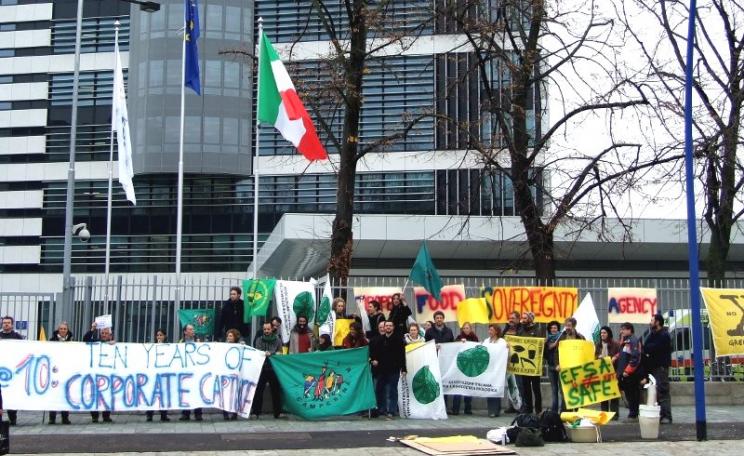As indicated by IARC concerns about glyphosate's cancer-causing properties are long standing and their earlier rejection by US-EPA was paradoxical and appeared to go against its own advisory panel's recommendation.
A monograph published by the International Agency for Research on Cancer (IARC) - of which a summary is published in the scientific journal The Lancet Oncology - has branded the herbicide glyphosate as "probably carcinogenic to humans".
The insecticides malathion and diazinon received the same calassification (Group 2A) while the tetrachlorvinphos and parathion were classified as "possibly carcinogenic to humans" (Group 2B) based on convincing evidence that these agents cause cancer in laboratory animals.
The designation follows a meeting earlier this month of 17 IARC experts at the orgnization's headquarters in Lyons, France, to assess the carcinogenicity of the five widely used organophosphate pesticides.
According to the Lancet article, "Glyphosate has been detected in air during spraying, in water, and in food. There was limited evidence in humans for the carcinogenicity of glyphosate.
"Case-control studies of occupational exposure in the USA, Canada, and Sweden reported increased risks for non-Hodgkin lymphoma that persisted after adjustment for other pesticides. The AHS cohort did not show a significantly increased risk of non-Hodgkin lymphoma."
Glyphosate is a broad-spectrum herbicide, currently with the highest production volumes of all herbicides, and as IARC notes, "it is used in more than 750 different products for agriculture, forestry, urban, and home applications. Its use has increased sharply with the development of genetically modified glyphosate-resistant crop varieties."
The full assessments of the five chemicals will be published as volume 112 of the IARC Monographs.
Supported by animal and cell line studies
Additional evidence of glyphosate's carcinogenicity arose from animal experiments: "In male CD-1 mice, glyphosate induced a positive trend in the incidence of a rare tumour, renal tubule carcinoma.
"A second study reported a positive trend for haemangiosarcoma in male mice. Glyphosate increased pancreatic islet-cell adenoma in male rats in two studies. A glyphosate formulation promoted skin tumours in an initiation-promotion study in mice."
The paper adds that glyphosate and its numerous formulations "induced DNA and chromosomal damage in mammals, and in human and animal cells in vitro.
"One study reported increases in blood markers of chromosomal damage (micronuclei) in residents of several communities after spraying of glyphosate formulations. Bacterial mutagenesis tests were negative. Glyphosate, glyphosate formulations, and AMPA induced oxidative stress in rodents and in vitro."
Glyphosate "has been detected in the blood and urine of agricultural workers, indicating absorption", the paper notes. It adds that the presence of aminomethylphosphoric acid (AMPA) in human blood after glyphosate poisoning "suggests intestinal microbial metabolism in humans" similar to that performed by soil bacteria.
As indicated by IARC concerns about glyphosate's cancer-causing properties are long standing and their earlier rejection by US-EPA was paradoxical and appeared to go against its own advisory panel's recommendation.
The Working Group classified glyphosate as "probably carcinogenic to humans".
'You can drink it like lemonade'
The findings are a fatal blow to industry claims that glyphosate is harmless and the oft-repeated canard that "you can drink it like lemonade" without ill-effect.
It also adds to pressure for regulators including the Europeran Food Standards Agency (EFSA) and the US Environmental Protection Agency (US-EPA) to re-examine the basis on whicht he product has been licenced.
The IARC draws attention to regulatory anomalies in the press release that accompanies the Lancet publication, noting: "On the basis of tumours in mice, the United States Environmental Protection Agency (US EPA) originally classified glyphosate as possibly carcinogenic to humans (Group C) in 1985.
"After a re-evaluation of that mouse study, the US EPA changed its classification to evidence of non-carcinogenicity in humans (Group E) in 1991. The US EPA Scientific Advisory Panel noted that the re-evaluated glyphosate results were still significant using two statistical tests recommended in the IARC Preamble.
"The IARC Working Group that conducted the evaluation considered the significant findings from the US EPA report and several more recent positive results in concluding that there is sufficient evidence of carcinogenicity in experimental animals."
Agro-chemical industry rejects IARC findings
Monsanto, which owns to now-expired patents on glyphosate and maker of the world's leading glyphosate formulation, Roundup, rejects the IARC findings, insisting that "all labeled uses of glyphosate are safe for human health and supported by one of the most extensive worldwide human health databases ever compiled on an agricultural product."
The conclusion, said Monsanto's Vice President Global Regulatory Affairs Philip Miller, "is not supported by scientific data ... We don't know how IARC could reach a conclusion that is such a dramatic departure from the conclusion reached by all regulatory agencies around the globe."
But as indicated by IARC concerns about glyphosate's cancer-causing properties are long standing and their earlier rejection by US-EPA was paradoxical and appeared to go against its own advisory panel's recommendation.
And of course the IARC study excludes other concerns as to glyphosate's wider toxicity, for example as a teratogen that gives rise to birth defects, as a endocrine disruptor and as a genotoxin.
It also does not consider the critical issue of the enhancement of glyphosate's toxicity caused by other elements such as adjuvants and surfactants in herbicide formulations.
The paper: 'Carcinogenicity of tetrachlorvinphos, parathion, malathion, diazinon, and glyphosate' is published in The Lancet Oncology.
More information:
- 'Roundup - a converging pattern of toxicity from farm to clinic to laboratory'.
- 'Glyphosate and Cancer'.







